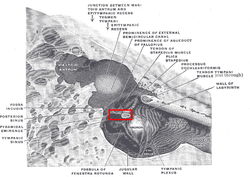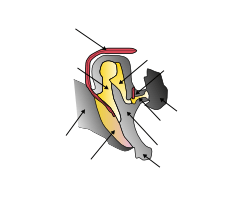Stapedius muscle
The stapedius is the smallest skeletal muscle in the human body. At just over one millimeter in length, its purpose is to stabilize the smallest bone in the body, the stapes.
| Stapedius | |
|---|---|
 The medial wall and part of the posterior and anterior walls of the right tympanic cavity, lateral view. | |
 Tensor tympani
Stapedius
Labyrinth
Tympanic membrane
(Ear drum) Bones and muscles in the tympanic cavity in the middle ear | |
| Details | |
| Origin | Walls of pyramidal eminence |
| Insertion | Neck of stapes |
| Artery | Stapedial branch of posterior auricular artery |
| Nerve | Facial nerve (nerve to stapedius) |
| Actions | Control the amplitude of sound waves to the inner ear |
| Identifiers | |
| Latin | Musculus stapedius |
| MeSH | D013198 |
| TA | A15.3.02.062 |
| FMA | 49027 |
| Anatomical terms of muscle | |
Structure
The stapedius emerges from a pinpoint foramen in the apex of the pyramidal eminence (a hollow, cone-shaped prominence in the posterior wall of the tympanic cavity), and inserts into the neck of the stapes.[1] :863
Nerve supply
The stapedius is supplied by the nerve to stapedius, a branch of the facial nerve.[1] :863
Function
The stapedius dampens the vibrations of the stapes by pulling on the neck of that bone.[1] :863 As one of the muscles involved in the acoustic reflex it prevents excess movement of the stapes, helping to control the amplitude of sound waves from the general external environment to the inner ear.[2]
Clinical significance
Paralysis of the stapedius allows wider oscillation of the stapes, resulting in heightened reaction of the auditory ossicles to sound vibration. This condition, known as hyperacusis, causes normal sounds to be perceived as very loud. Paralysis of the stapedius muscle may result when the nerve to the stapedius, a branch of the facial nerve, is damaged, or when the facial nerve itself is damaged before the nerve to stapedius branches. In cases of Bell's palsy, a unilateral paralysis of the facial nerve, the stapedius is paralyzed and hyperacusis may result.[2]
Other animals
Like the stapes bone to which it attaches, the stapedius muscle shares evolutionary history with other vertebrate structures.
The mammalian stapedius evolved from a muscle called the depressor mandibulae in other tetrapods, the function of which was to open the jaws (this function was taken over by the digastric muscle in mammals). The depressor mandibulae arose from the levator operculi in bony fish, and is equivalent to the epihyoidean in sharks. Like the stapedius, all of these muscles derive from the hyoid arch and are innervated by cranial nerve VII.[3]
See also
- Hearing
- Middle ear
- Ossicles
- Tensor tympani – the other major muscle in the middle ear
- Stapes – the other bone to which the muscle attaches
References
- Drake, Richard L.; Vogl, Wayne; Tibbitts, Adam W.M. Mitchell; illustrations by Richard; Richardson, Paul (2005). Gray's anatomy for students. Philadelphia: Elsevier/Churchill Livingstone. ISBN 978-0-8089-2306-0.
- Moore, Keith L.; Dalley, Arthur F.; Agur, A. M. R. (2013-02-13). Clinically Oriented Anatomy. Lippincott Williams & Wilkins. ISBN 9781451119459.
- Kardong, Kenneth V. (1995). Vertebrates: comparative anatomy, function, evolution. McGraw-Hill. pp. 55, 57. ISBN 0-697-21991-7.